Question Number 41555 by Raj Singh last updated on 09/Aug/18

Answered by alex041103 last updated on 09/Aug/18
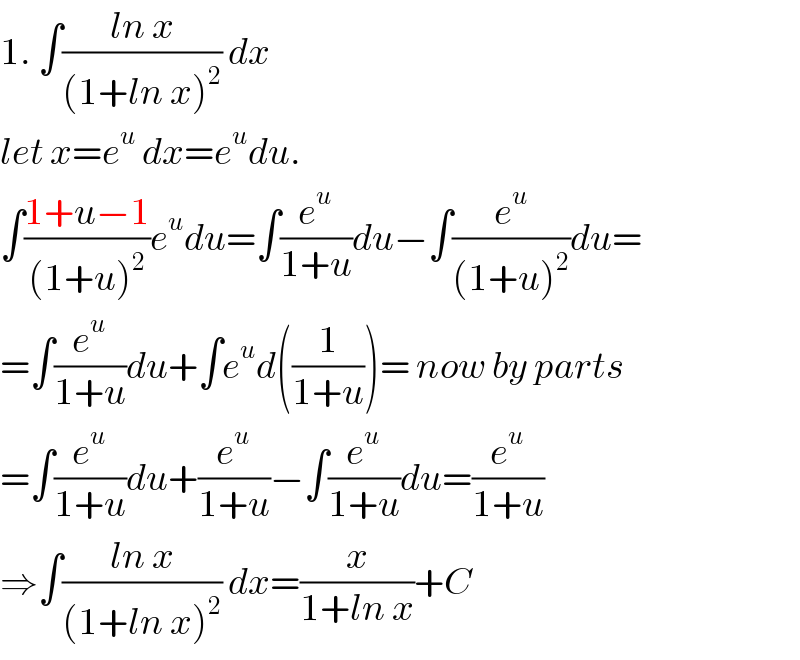
$$\mathrm{1}.\:\int\frac{{ln}\:{x}}{\left(\mathrm{1}+{ln}\:{x}\right)^{\mathrm{2}} }\:{dx} \\ $$$${let}\:{x}={e}^{{u}} \:{dx}={e}^{{u}} {du}. \\ $$$$\int\frac{\mathrm{1}+{u}−\mathrm{1}}{\left(\mathrm{1}+{u}\right)^{\mathrm{2}} }{e}^{{u}} {du}=\int\frac{{e}^{{u}} }{\mathrm{1}+{u}}{du}−\int\frac{{e}^{{u}} }{\left(\mathrm{1}+{u}\right)^{\mathrm{2}} }{du}= \\ $$$$=\int\frac{{e}^{{u}} }{\mathrm{1}+{u}}{du}+\int{e}^{{u}} {d}\left(\frac{\mathrm{1}}{\mathrm{1}+{u}}\right)=\:{now}\:{by}\:{parts} \\ $$$$=\int\frac{{e}^{{u}} }{\mathrm{1}+{u}}{du}+\frac{{e}^{{u}} }{\mathrm{1}+{u}}−\int\frac{{e}^{{u}} }{\mathrm{1}+{u}}{du}=\frac{{e}^{{u}} }{\mathrm{1}+{u}} \\ $$$$\Rightarrow\int\frac{{ln}\:{x}}{\left(\mathrm{1}+{ln}\:{x}\right)^{\mathrm{2}} }\:{dx}=\frac{{x}}{\mathrm{1}+{ln}\:{x}}+{C} \\ $$
Answered by tanmay.chaudhury50@gmail.com last updated on 09/Aug/18
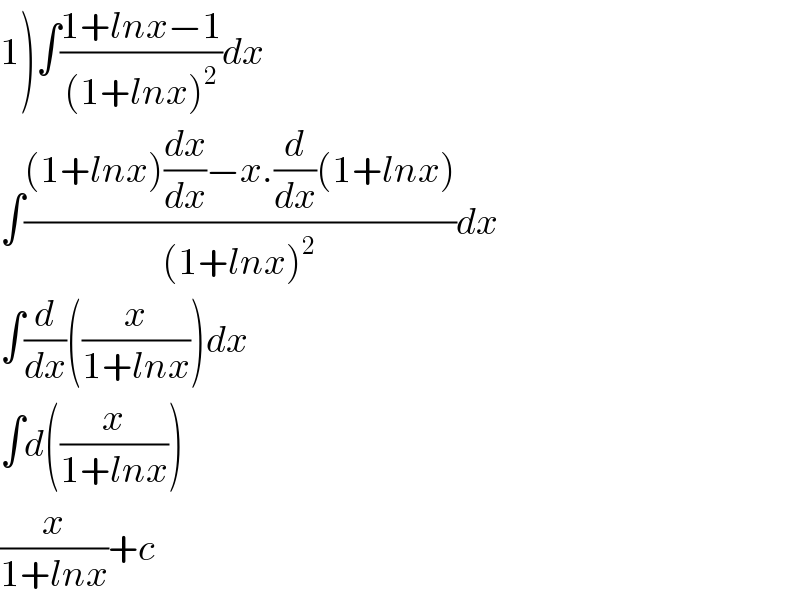
$$\left.\mathrm{1}\right)\int\frac{\mathrm{1}+{lnx}−\mathrm{1}}{\left(\mathrm{1}+{lnx}\right)^{\mathrm{2}} }{dx} \\ $$$$\int\frac{\left(\mathrm{1}+{lnx}\right)\frac{{dx}}{{dx}}−{x}.\frac{{d}}{{dx}}\left(\mathrm{1}+{lnx}\right)}{\left(\mathrm{1}+{lnx}\right)^{\mathrm{2}} }{dx} \\ $$$$\int\frac{{d}}{{dx}}\left(\frac{{x}}{\mathrm{1}+{lnx}}\right){dx} \\ $$$$\int{d}\left(\frac{{x}}{\mathrm{1}+{lnx}}\right) \\ $$$$\frac{{x}}{\mathrm{1}+{lnx}}+{c} \\ $$
Answered by alex041103 last updated on 09/Aug/18
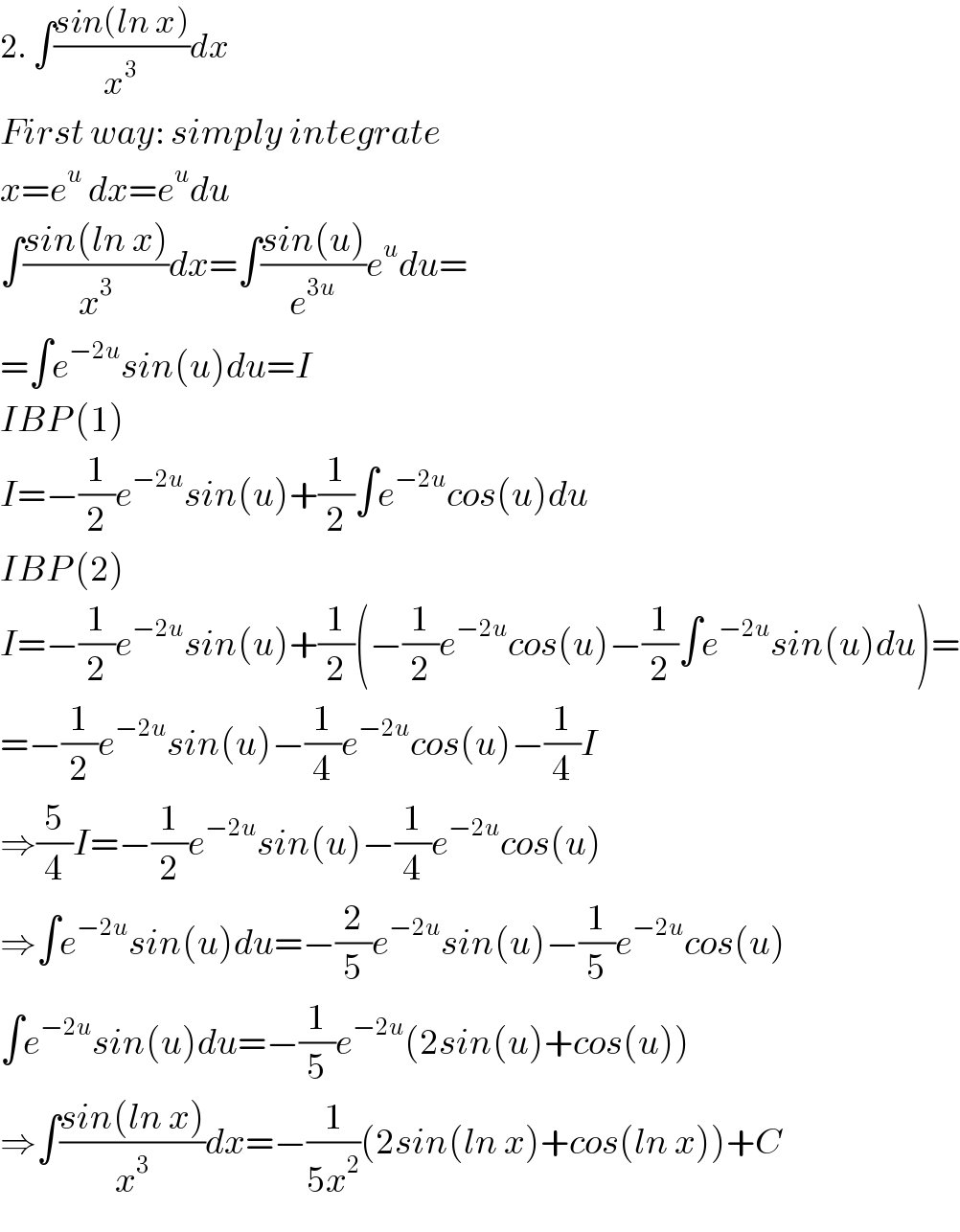
$$\mathrm{2}.\:\int\frac{{sin}\left({ln}\:{x}\right)}{{x}^{\mathrm{3}} }{dx} \\ $$$${First}\:{way}:\:{simply}\:{integrate} \\ $$$${x}={e}^{{u}} \:{dx}={e}^{{u}} {du} \\ $$$$\int\frac{{sin}\left({ln}\:{x}\right)}{{x}^{\mathrm{3}} }{dx}=\int\frac{{sin}\left({u}\right)}{{e}^{\mathrm{3}{u}} }{e}^{{u}} {du}= \\ $$$$=\int{e}^{−\mathrm{2}{u}} {sin}\left({u}\right){du}={I} \\ $$$${IBP}\:\left(\mathrm{1}\right) \\ $$$${I}=−\frac{\mathrm{1}}{\mathrm{2}}{e}^{−\mathrm{2}{u}} {sin}\left({u}\right)+\frac{\mathrm{1}}{\mathrm{2}}\int{e}^{−\mathrm{2}{u}} {cos}\left({u}\right){du} \\ $$$${IBP}\:\left(\mathrm{2}\right) \\ $$$${I}=−\frac{\mathrm{1}}{\mathrm{2}}{e}^{−\mathrm{2}{u}} {sin}\left({u}\right)+\frac{\mathrm{1}}{\mathrm{2}}\left(−\frac{\mathrm{1}}{\mathrm{2}}{e}^{−\mathrm{2}{u}} {cos}\left({u}\right)−\frac{\mathrm{1}}{\mathrm{2}}\int{e}^{−\mathrm{2}{u}} {sin}\left({u}\right){du}\right)= \\ $$$$=−\frac{\mathrm{1}}{\mathrm{2}}{e}^{−\mathrm{2}{u}} {sin}\left({u}\right)−\frac{\mathrm{1}}{\mathrm{4}}{e}^{−\mathrm{2}{u}} {cos}\left({u}\right)−\frac{\mathrm{1}}{\mathrm{4}}{I} \\ $$$$\Rightarrow\frac{\mathrm{5}}{\mathrm{4}}{I}=−\frac{\mathrm{1}}{\mathrm{2}}{e}^{−\mathrm{2}{u}} {sin}\left({u}\right)−\frac{\mathrm{1}}{\mathrm{4}}{e}^{−\mathrm{2}{u}} {cos}\left({u}\right) \\ $$$$\Rightarrow\int{e}^{−\mathrm{2}{u}} {sin}\left({u}\right){du}=−\frac{\mathrm{2}}{\mathrm{5}}{e}^{−\mathrm{2}{u}} {sin}\left({u}\right)−\frac{\mathrm{1}}{\mathrm{5}}{e}^{−\mathrm{2}{u}} {cos}\left({u}\right) \\ $$$$\int{e}^{−\mathrm{2}{u}} {sin}\left({u}\right){du}=−\frac{\mathrm{1}}{\mathrm{5}}{e}^{−\mathrm{2}{u}} \left(\mathrm{2}{sin}\left({u}\right)+{cos}\left({u}\right)\right) \\ $$$$\Rightarrow\int\frac{{sin}\left({ln}\:{x}\right)}{{x}^{\mathrm{3}} }{dx}=−\frac{\mathrm{1}}{\mathrm{5}{x}^{\mathrm{2}} }\left(\mathrm{2}{sin}\left({ln}\:{x}\right)+{cos}\left({ln}\:{x}\right)\right)+{C} \\ $$
Commented by alex041103 last updated on 09/Aug/18
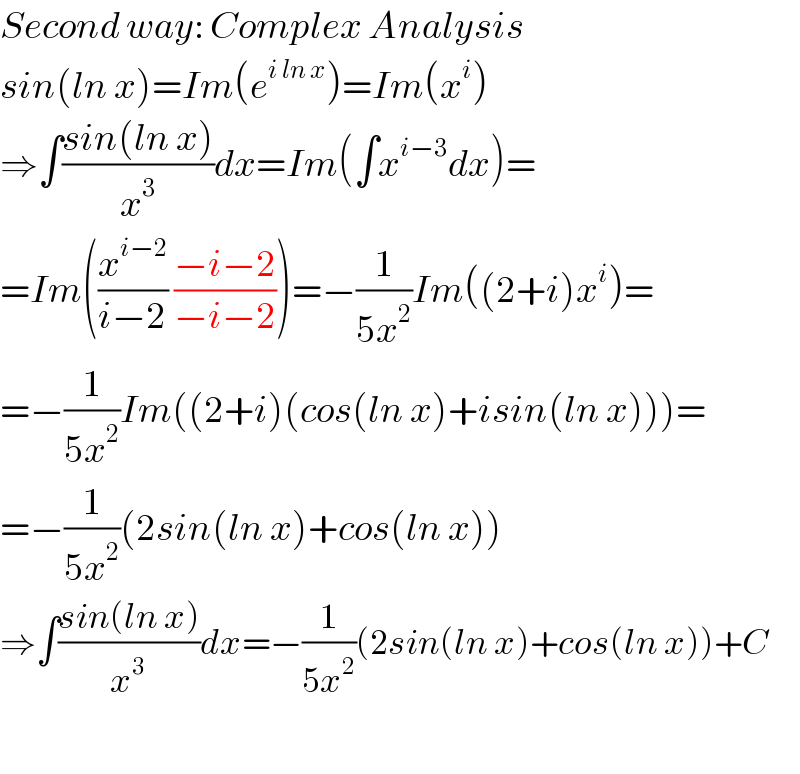
$${Second}\:{way}:\:{Complex}\:{Analysis} \\ $$$${sin}\left({ln}\:{x}\right)={Im}\left({e}^{{i}\:{ln}\:{x}} \right)={Im}\left({x}^{{i}} \right) \\ $$$$\Rightarrow\int\frac{{sin}\left({ln}\:{x}\right)}{{x}^{\mathrm{3}} }{dx}={Im}\left(\int{x}^{{i}−\mathrm{3}} {dx}\right)= \\ $$$$={Im}\left(\frac{{x}^{{i}−\mathrm{2}} }{{i}−\mathrm{2}}\:\frac{−{i}−\mathrm{2}}{−{i}−\mathrm{2}}\right)=−\frac{\mathrm{1}}{\mathrm{5}{x}^{\mathrm{2}} }{Im}\left(\left(\mathrm{2}+{i}\right){x}^{{i}} \right)= \\ $$$$=−\frac{\mathrm{1}}{\mathrm{5}{x}^{\mathrm{2}} }{Im}\left(\left(\mathrm{2}+{i}\right)\left({cos}\left({ln}\:{x}\right)+{isin}\left({ln}\:{x}\right)\right)\right)= \\ $$$$=−\frac{\mathrm{1}}{\mathrm{5}{x}^{\mathrm{2}} }\left(\mathrm{2}{sin}\left({ln}\:{x}\right)+{cos}\left({ln}\:{x}\right)\right) \\ $$$$\Rightarrow\int\frac{{sin}\left({ln}\:{x}\right)}{{x}^{\mathrm{3}} }{dx}=−\frac{\mathrm{1}}{\mathrm{5}{x}^{\mathrm{2}} }\left(\mathrm{2}{sin}\left({ln}\:{x}\right)+{cos}\left({ln}\:{x}\right)\right)+{C} \\ $$$$ \\ $$
Answered by tanmay.chaudhury50@gmail.com last updated on 09/Aug/18
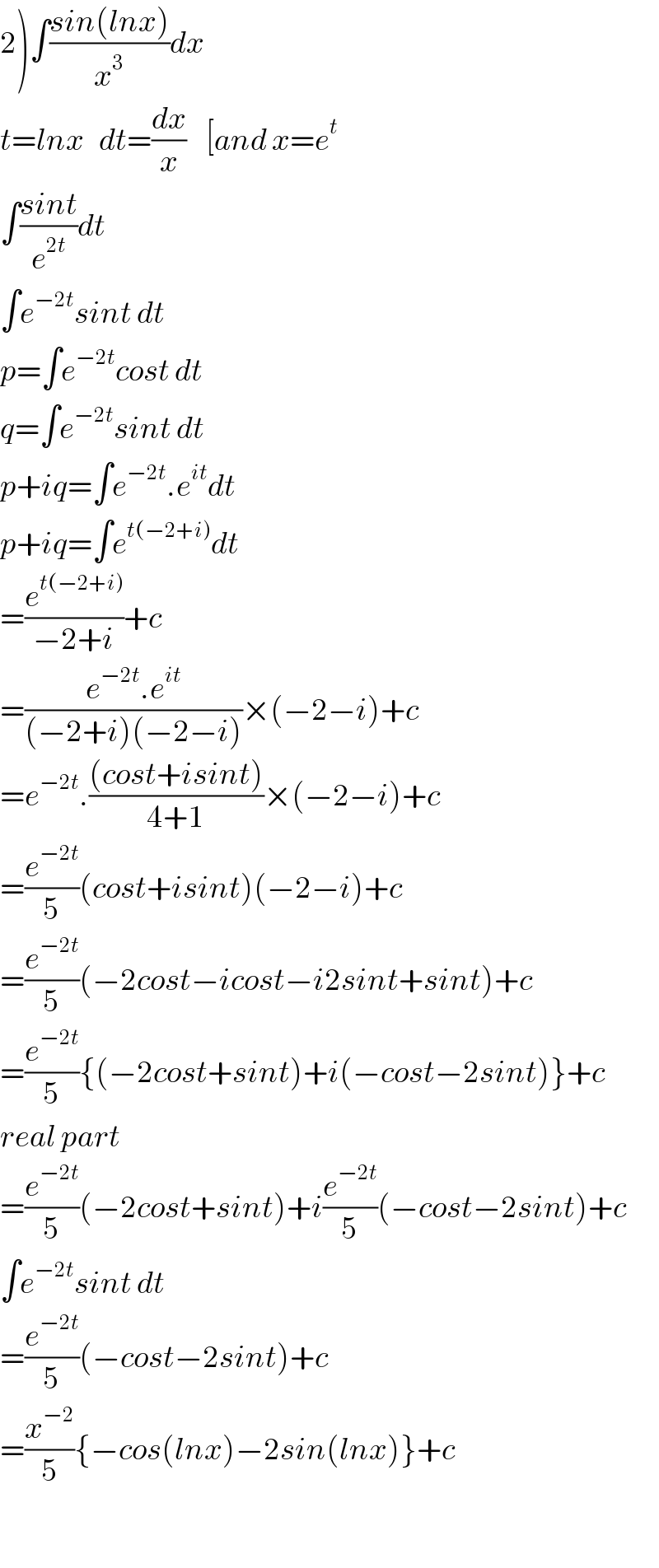
$$\left.\mathrm{2}\right)\int\frac{{sin}\left({lnx}\right)}{{x}^{\mathrm{3}} }{dx} \\ $$$${t}={lnx}\:\:\:{dt}=\frac{{dx}}{{x}}\:\:\:\:\left[{and}\:{x}={e}^{{t}} \right. \\ $$$$\int\frac{{sint}}{{e}^{\mathrm{2}{t}} }{dt} \\ $$$$\int{e}^{−\mathrm{2}{t}} {sint}\:{dt} \\ $$$${p}=\int{e}^{−\mathrm{2}{t}} {cost}\:{dt} \\ $$$${q}=\int{e}^{−\mathrm{2}{t}} {sint}\:{dt} \\ $$$${p}+{iq}=\int{e}^{−\mathrm{2}{t}} .{e}^{{it}} {dt} \\ $$$${p}+{iq}=\int{e}^{{t}\left(−\mathrm{2}+{i}\right)} {dt} \\ $$$$=\frac{{e}^{{t}\left(−\mathrm{2}+{i}\right)} }{−\mathrm{2}+{i}}+{c} \\ $$$$=\frac{{e}^{−\mathrm{2}{t}} .{e}^{{it}} }{\left(−\mathrm{2}+{i}\right)\left(−\mathrm{2}−{i}\right)}×\left(−\mathrm{2}−{i}\right)+{c} \\ $$$$={e}^{−\mathrm{2}{t}} .\frac{\left({cost}+{isint}\right)}{\mathrm{4}+\mathrm{1}}×\left(−\mathrm{2}−{i}\right)+{c} \\ $$$$=\frac{{e}^{−\mathrm{2}{t}} }{\mathrm{5}}\left({cost}+{isint}\right)\left(−\mathrm{2}−{i}\right)+{c} \\ $$$$=\frac{{e}^{−\mathrm{2}{t}} }{\mathrm{5}}\left(−\mathrm{2}{cost}−{icost}−{i}\mathrm{2}{sint}+{sint}\right)+{c} \\ $$$$=\frac{{e}^{−\mathrm{2}{t}} }{\mathrm{5}}\left\{\left(−\mathrm{2}{cost}+{sint}\right)+{i}\left(−{cost}−\mathrm{2}{sint}\right)\right\}+{c} \\ $$$${real}\:{part} \\ $$$$=\frac{{e}^{−\mathrm{2}{t}} }{\mathrm{5}}\left(−\mathrm{2}{cost}+{sint}\right)+{i}\frac{{e}^{−\mathrm{2}{t}} }{\mathrm{5}}\left(−{cost}−\mathrm{2}{sint}\right)+{c} \\ $$$$\int{e}^{−\mathrm{2}{t}} {sint}\:{dt} \\ $$$$=\frac{{e}^{−\mathrm{2}{t}} }{\mathrm{5}}\left(−{cost}−\mathrm{2}{sint}\right)+{c} \\ $$$$=\frac{{x}^{−\mathrm{2}} }{\mathrm{5}}\left\{−{cos}\left({lnx}\right)−\mathrm{2}{sin}\left({lnx}\right)\right\}+{c} \\ $$$$ \\ $$
Answered by maxmathsup by imad last updated on 09/Aug/18
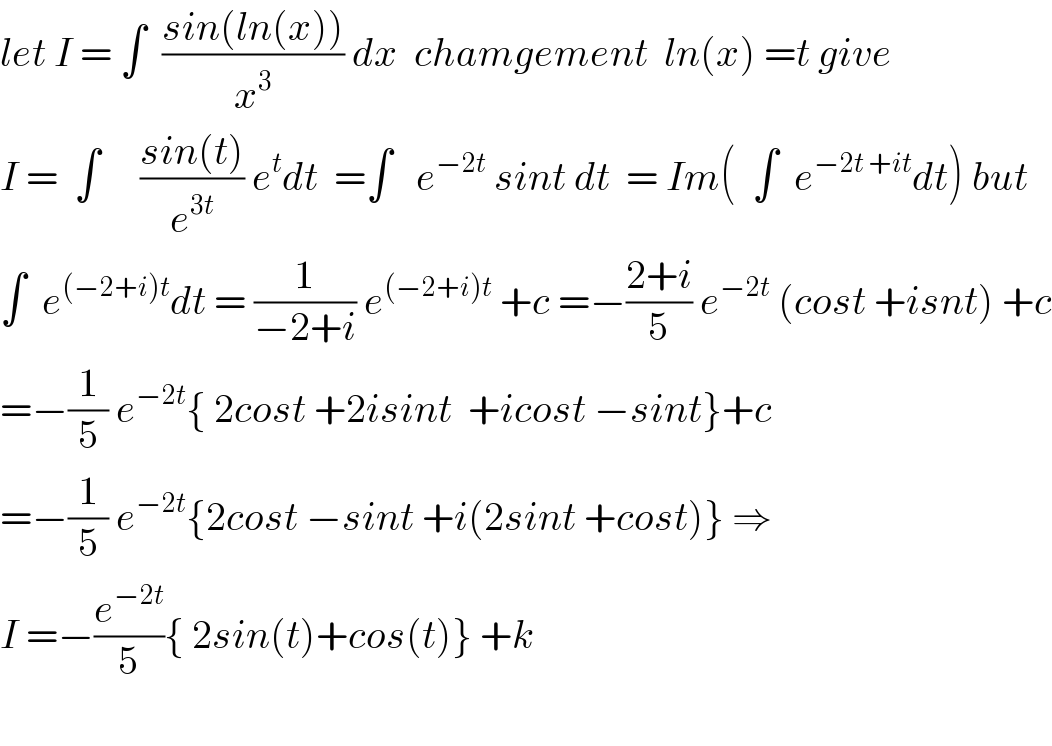
$${let}\:{I}\:=\:\int\:\:\frac{{sin}\left({ln}\left({x}\right)\right)}{{x}^{\mathrm{3}} }\:{dx}\:\:{chamgement}\:\:{ln}\left({x}\right)\:={t}\:{give} \\ $$$${I}\:=\:\:\int\:\:\:\:\:\frac{{sin}\left({t}\right)}{{e}^{\mathrm{3}{t}} }\:{e}^{{t}} {dt}\:\:=\int\:\:\:{e}^{−\mathrm{2}{t}} \:{sint}\:{dt}\:\:=\:{Im}\left(\:\:\int\:\:{e}^{−\mathrm{2}{t}\:+{it}} {dt}\right)\:{but} \\ $$$$\int\:\:{e}^{\left(−\mathrm{2}+{i}\right){t}} {dt}\:=\:\frac{\mathrm{1}}{−\mathrm{2}+{i}}\:{e}^{\left(−\mathrm{2}+{i}\right){t}} \:+{c}\:=−\frac{\mathrm{2}+{i}}{\mathrm{5}}\:{e}^{−\mathrm{2}{t}} \:\left({cost}\:+{isnt}\right)\:+{c} \\ $$$$=−\frac{\mathrm{1}}{\mathrm{5}}\:{e}^{−\mathrm{2}{t}} \left\{\:\mathrm{2}{cost}\:+\mathrm{2}{isint}\:\:+{icost}\:−{sint}\right\}+{c} \\ $$$$=−\frac{\mathrm{1}}{\mathrm{5}}\:{e}^{−\mathrm{2}{t}} \left\{\mathrm{2}{cost}\:−{sint}\:+{i}\left(\mathrm{2}{sint}\:+{cost}\right)\right\}\:\Rightarrow \\ $$$${I}\:=−\frac{{e}^{−\mathrm{2}{t}} }{\mathrm{5}}\left\{\:\mathrm{2}{sin}\left({t}\right)+{cos}\left({t}\right)\right\}\:+{k}\: \\ $$$$ \\ $$
Commented by maxmathsup by imad last updated on 09/Aug/18

$${but}\:{t}\:={ln}\left({x}\right)\:\Rightarrow\:{I}\:=−\frac{\mathrm{1}}{\mathrm{5}{x}^{\mathrm{2}} }\left\{\:\mathrm{2}{sin}\left({ln}\left({x}\right)\right)\:+{cos}\left({ln}\left({x}\right)\right)\right\}\:+{k}\: \\ $$
